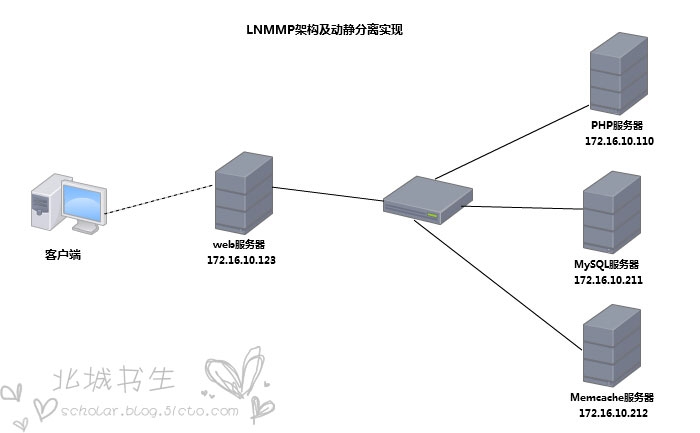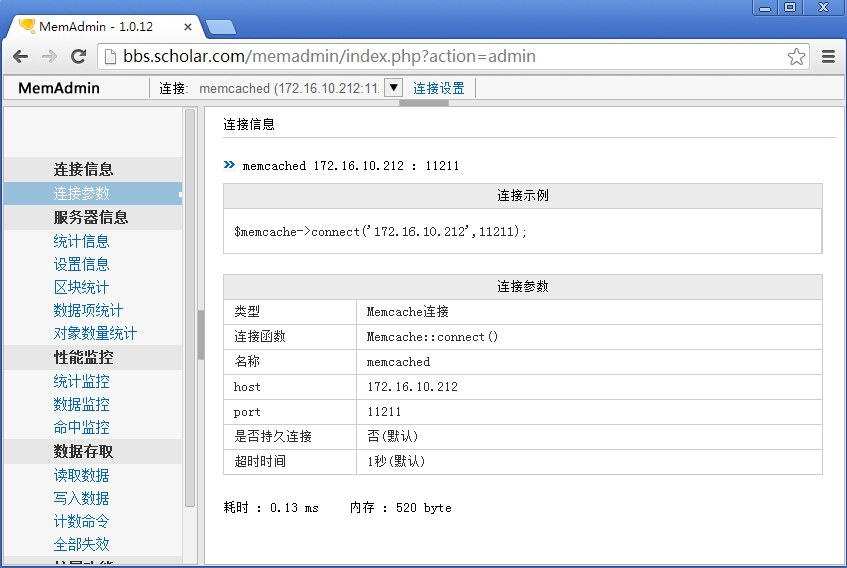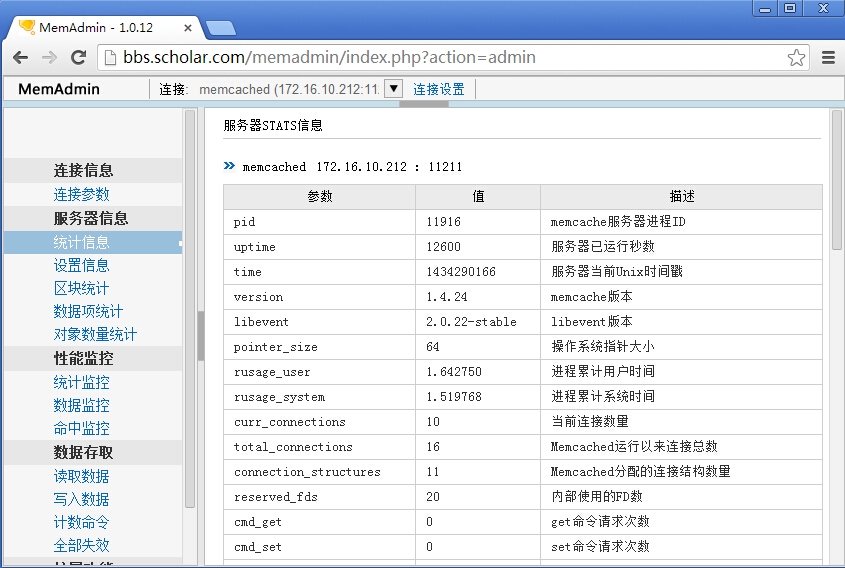LNMMP架构实现Web动静分离
转载于
北城书生 的BLOG
http://scholar.blog.51cto.com/9985645/1661861
前言
前 面的文章中说过LAMP架构包括:Linux操作系统,Apache网站服务器,MySQL数据库,Perl、PHP或者Python编程语言,而今天要 说的LNMMP 和LAMP类似,只是作为Web服务器的不再是Apache而是高性能的Nginx,同时引进Memcached加速缓存效率,用于加快 访问速度。
Memcached是一款开源、高性能、分布式内存对象缓存系统,可应用各种需要缓存的场景,其主要目的是通过降低对数据库的访问来加速Web应用程序。它是一个基于内存的“键值对”存储,用于存储数据库调用、API调用或页面引用结果的直接数据,如字符串、对象等。
实现过程
实验拓扑

实验环境
系统环境:CentOS6.6
web服务器:172.16.10.123 nginx-1.6.3
PHP服务器:172.16.10.110 php-5.4.26
数据库服务器:172.16.10.211 MariaDB-5.5.36
Memcached服务器:172.16.10.212 memcached-1.4.24
工作原理
利用nginx的高性能特点做前端反向代理服务器,分发用户请求,静态请求直接返回结果,动态请求交给后端php处理,php查询数据库返回处理结果,并将结果缓存至Memcached,当接收新请求时,php首先在Memcached查询,Memcached有结果直接返还给nginx,没结果再查询数据库,依次类推。
安装配置nginx
|
1
2
3
4
5
6
7
8
9
10
11
12
13
14
15
16
17
18
19
20
21
22
23
24
25
26
27
28
|
#解决依赖关系
[root@node1 ~]
# yum groupinstall "Development Tools" "Server Platform Deveopment" -y
[root@node1 ~]
# yum install openssl-devel pcre-devel -y
[root@node1 ~]
# groupadd -r nginx
[root@node1 ~]
# useradd -r -g nginx nginx
[root@node1 ~]
# tar xf nginx-1.6.3.tar.gz
[root@node1 ~]
# cd nginx-1.6.3
[root@node1 nginx-1.6.3]
# ./configure \
> --prefix=
/usr/local/nginx
\
> --sbin-path=
/usr/sbin/nginx
\
> --conf-path=
/etc/nginx/nginx
.conf \
> --error-log-path=
/var/log/nginx/error
.log \
> --http-log-path=
/var/log/nginx/access
.log \
> --pid-path=
/var/run/nginx/nginx
.pid \
> --lock-path=
/var/lock/nginx
.lock \
> --user=nginx \
> --group=nginx \
> --with-http_ssl_module \
> --with-http_flv_module \
> --with-http_stub_status_module \
> --with-http_gzip_static_module \
> --http-client-body-temp-path=
/usr/local/nginx/client/
\
> --http-proxy-temp-path=
/usr/local/nginx/proxy/
\
> --http-fastcgi-temp-path=
/usr/local/nginx/fcgi/
\
> --http-uwsgi-temp-path=
/usr/local/nginx/uwsgi
\
> --http-scgi-temp-path=
/usr/local/nginx/scgi
\
> --with-pcre
[root@node1 nginx-1.6.3]
# make && make install
|
为nginx提供SysV init脚本
|
1
2
3
4
5
6
7
8
9
10
11
12
13
14
15
16
17
18
19
20
21
22
23
24
25
26
27
28
29
30
31
32
33
34
35
36
37
38
39
40
41
42
43
44
45
46
47
48
49
50
51
52
53
54
55
56
57
58
59
60
61
62
63
64
65
66
67
68
69
70
71
72
73
74
75
76
77
78
79
80
81
82
83
84
85
86
87
88
89
90
91
92
93
94
95
96
97
98
99
100
101
102
103
104
105
106
107
108
109
110
111
112
113
114
115
116
117
118
119
120
121
122
123
124
125
126
127
128
129
|
[root@node1 ~]
# vim /etc/rc.d/init.d/nginx
#新建文件/etc/rc.d/init.d/nginx,内容如下:
#!/bin/sh
#
# nginx - this script starts and stops the nginx daemon
#
# chkconfig: - 85 15
# description: Nginx is an HTTP(S) server, HTTP(S) reverse \
# proxy and IMAP/POP3 proxy server
# processname: nginx
# config: /etc/nginx/nginx.conf
# config: /etc/sysconfig/nginx
# pidfile: /var/run/nginx.pid
# Source function library.
.
/etc/rc
.d
/init
.d
/functions
# Source networking configuration.
.
/etc/sysconfig/network
# Check that networking is up.
[
"$NETWORKING"
=
"no"
] &&
exit
0
nginx=
"/usr/sbin/nginx"
prog=$(
basename
$nginx)
NGINX_CONF_FILE=
"/etc/nginx/nginx.conf"
[ -f
/etc/sysconfig/nginx
] && .
/etc/sysconfig/nginx
lockfile=
/var/lock/subsys/nginx
make_dirs() {
# make required directories
user=`nginx -V 2>&1 |
grep
"configure arguments:"
|
sed
's/[^*]*--user=\([^ ]*\).*/\1/g'
-`
options=`$nginx -V 2>&1 |
grep
'configure arguments:'
`
for
opt
in
$options;
do
if
[ `
echo
$opt |
grep
'.*-temp-path'
` ];
then
value=`
echo
$opt |
cut
-d
"="
-f 2`
if
[ ! -d
"$value"
];
then
# echo "creating" $value
mkdir
-p $value &&
chown
-R $user $value
fi
fi
done
}
start() {
[ -x $nginx ] ||
exit
5
[ -f $NGINX_CONF_FILE ] ||
exit
6
make_dirs
echo
-n $
"Starting $prog: "
daemon $nginx -c $NGINX_CONF_FILE
retval=$?
echo
[ $retval -
eq
0 ] &&
touch
$lockfile
return
$retval
}
stop() {
echo
-n $
"Stopping $prog: "
killproc $prog -QUIT
retval=$?
echo
[ $retval -
eq
0 ] &&
rm
-f $lockfile
return
$retval
}
restart() {
configtest ||
return
$?
stop
sleep
1
start
}
reload() {
configtest ||
return
$?
echo
-n $
"Reloading $prog: "
killproc $nginx -HUP
RETVAL=$?
echo
}
force_reload() {
restart
}
configtest() {
$nginx -t -c $NGINX_CONF_FILE
}
rh_status() {
status $prog
}
rh_status_q() {
rh_status >
/dev/null
2>&1
}
case
"$1"
in
start)
rh_status_q &&
exit
0
$1
;;
stop)
rh_status_q ||
exit
0
$1
;;
restart|configtest)
$1
;;
reload)
rh_status_q ||
exit
7
$1
;;
force-reload)
force_reload
;;
status)
rh_status
;;
condrestart|try-restart)
rh_status_q ||
exit
0
;;
*)
echo
$"Usage: $0 {start|stop|status|restart|condrestart|try-restart|reload|force-
reload|configtest}"
exit
2
esac
|
为脚本赋予执行权限
|
1
|
[root@node1 ~]
# chmod +x /etc/rc.d/init.d/nginx
|
添加至服务管理列表,并让其开机自动启动
|
1
2
|
[root@node1 ~]
# chkconfig --add nginx
[root@node1 ~]
# chkconfig nginx on
|
配置nginx
|
1
2
3
4
5
6
7
8
9
10
11
12
13
14
15
16
17
18
19
20
21
22
23
24
25
26
27
28
29
30
31
32
33
34
35
36
37
38
39
40
41
42
43
44
45
46
47
48
49
50
51
52
53
54
55
56
|
[root@node1 ~]
# vim /etc/nginx/nginx.conf
worker_processes 2;
#worker进程的个数
error_log
/var/log/nginx/error
.log notice;
#错误日志路径及级别
events {
worker_connections 1024;
#每个worker能够并发响应的最大请求数
}
http {
include mime.types;
#支持多媒体类型
default_type application
/octet-stream
;
sendfile on;
#由内核直接转发
#keepalive_timeout 0;
keepalive_timeout 5;
#持久连接5s
gzip
on;
#开启压缩功能
server {
listen 80;
server_name bbs.scholar.com;
add_header X-via $server_addr;
#让客户端能够看到代理服务器的IP
location / {
root
/www/bbs
;
index index.php index.html index.htm;
}
location ~* \.(jpg|jpeg|png|gif|js|css)$ {
#匹配静态内容
root
/www/bbs
;
}
location ~ \.php$ {
#匹配动态内容
root
/www/bbs
;
fastcgi_pass 172.16.10.110:9000;
#代理到的服务器
fastcgi_index index.php;
fastcgi_param SCRIPT_FILENAME scripts$fastcgi_script_name;
include fastcgi_params;
}
}
}
[root@node1 ~]
# vim /etc/nginx/fastcgi_params
fastcgi_param GATEWAY_INTERFACE CGI
/1
.1;
fastcgi_param SERVER_SOFTWARE nginx;
fastcgi_param QUERY_STRING $query_string;
fastcgi_param REQUEST_METHOD $request_method;
fastcgi_param CONTENT_TYPE $content_type;
fastcgi_param CONTENT_LENGTH $content_length;
fastcgi_param SCRIPT_FILENAME $document_root$fastcgi_script_name;
fastcgi_param SCRIPT_NAME $fastcgi_script_name;
fastcgi_param REQUEST_URI $request_uri;
fastcgi_param DOCUMENT_URI $document_uri;
fastcgi_param DOCUMENT_ROOT $document_root;
fastcgi_param SERVER_PROTOCOL $server_protocol;
fastcgi_param REMOTE_ADDR $remote_addr;
fastcgi_param REMOTE_PORT $remote_port;
fastcgi_param SERVER_ADDR $server_addr;
fastcgi_param SERVER_PORT $server_port;
fastcgi_param SERVER_NAME $server_name;
[root@node1 ~]
# service nginx start
|
安装配置memcached
|
1
2
3
4
5
6
7
8
9
10
11
12
13
14
15
|
#解决依赖关系
[root@scholar ~]
# yum groupinstall "Development Tools" "Server Platform Deveopment" -y
#安装libevent
#memcached依赖于libevent API,因此要事先安装之
[root@scholar ~]
# tar xf libevent-2.0.22-stable.tar.gz
[root@scholar ~]
# cd libevent-2.0.22-stable
[root@scholar libevent-2.0.22-stable]
# ./configure --prefix=/usr/local/libevent
[root@scholar libevent-2.0.22-stable]
# make && make install
[root@scholar ~]
# echo "/usr/local/libevent/lib" > /etc/ld.so.conf.d/libevent.conf
[root@scholar ~]
# ldconfig
#安装配置memcached
[root@scholar ~]
# tar xf memcached-1.4.24.tar.tar
[root@scholar ~]
# cd memcached-1.4.24
[root@scholar memcached-1.4.24]
# ./configure --prefix=/usr/local/memcached --with-libevent=/usr/local/libevent
[root@scholar memcached-1.4.24]
# make && make install
|
提供脚本
|
1
2
3
4
5
6
7
8
9
10
11
12
13
14
15
16
17
18
19
20
21
22
23
24
25
26
27
28
29
30
31
32
33
34
35
36
37
38
39
40
41
42
43
44
45
46
47
48
49
50
51
52
53
54
55
56
57
58
59
60
61
62
63
64
65
66
67
68
69
70
71
72
73
74
75
76
77
78
79
80
81
82
83
84
85
|
[root@scholar ~]
# vim /etc/init.d/memcached
#!/bin/bash
#
# Init file for memcached
#
# chkconfig: - 86 14
# description: Distributed memory caching daemon
#
# processname: memcached
# config: /etc/sysconfig/memcached
.
/etc/rc
.d
/init
.d
/functions
## Default variables
PORT=
"11211"
USER=
"nobody"
MAXCONN=
"1024"
CACHESIZE=
"64"
OPTIONS=
""
RETVAL=0
prog=
"/usr/local/memcached/bin/memcached"
desc=
"Distributed memory caching"
lockfile=
"/var/lock/subsys/memcached"
start() {
echo
-n $
"Starting $desc (memcached): "
daemon $prog -d -p $PORT -u $USER -c $MAXCONN -m $CACHESIZE -o
"$OPTIONS"
RETVAL=$?
[ $RETVAL -
eq
0 ] && success &&
touch
$lockfile || failure
echo
return
$RETVAL
}
stop() {
echo
-n $
"Shutting down $desc (memcached): "
killproc $prog
RETVAL=$?
[ $RETVAL -
eq
0 ] && success &&
rm
-f $lockfile || failure
echo
return
$RETVAL
}
restart() {
stop
start
}
reload() {
echo
-n $
"Reloading $desc ($prog): "
killproc $prog -HUP
RETVAL=$?
[ $RETVAL -
eq
0 ] && success || failure
echo
return
$RETVAL
}
case
"$1"
in
start)
start
;;
stop)
stop
;;
restart)
restart
;;
condrestart)
[ -e $lockfile ] && restart
RETVAL=$?
;;
reload)
reload
;;
status)
status $prog
RETVAL=$?
;;
*)
echo
$
"Usage: $0 {start|stop|restart|condrestart|status}"
RETVAL=1
esac
exit
$RETVAL
|
授权并启动服务
|
1
2
3
4
|
[root@scholar ~]
# vim /etc/init.d/memcached
[root@scholar ~]
# chmod +x /etc/init.d/memcached
[root@scholar ~]
# chkconfig --add memcached
[root@scholar ~]
# service memcached start
|
安装配置php
|
1
2
3
4
5
6
7
8
9
10
11
12
|
#解决依赖关系
[root@scholar ~]
# yum groupinstall "Development tools" "Server Platform Development" -y
[root@scholar ~]
# yum -y groupinstall "Desktop Platform Development"
[root@scholar ~]
# yum -y install bzip2-devel libmcrypt-devel
[root@scholar ~]
# tar xf php-5.4.26.tar.bz2
[root@scholar ~]
# cd php-5.4.26
[root@scholar php-5.4.26]
# ./configure --prefix=/usr/local/php --with-mysql=mysqlnd
--with-pdo-mysql=mysqlnd --with-mysqli=mysqlnd --
enable
-mbstring --with-freetype-
dir
--with-jpeg-
dir
--with-png-
dir
--with-zlib --with-libxml-
dir
=
/usr
--
enable
-xml
--
enable
-sockets --
enable
-fpm --with-mcrypt --with-config-
file
-path=
/etc
--with-config-
file
-scan-
dir
=
/etc/php
.d --with-bz2 --with-openssl
[root@scholar php-5.4.26]
# make && make install
|
提供配置文件
|
1
2
3
4
5
6
7
8
9
10
11
12
13
14
15
16
17
18
19
20
21
22
23
|
#为php提供配置文件
[root@scholar php-5.4.26]
# cp php.ini-production /etc/php.ini
#为php-fpm提供脚本
[root@scholar php-5.4.26]
# cp sapi/fpm/init.d.php-fpm /etc/rc.d/init.d/php-fpm
[root@scholar php-5.4.26]
# chmod +x /etc/rc.d/init.d/php-fpm
[root@scholar php-5.4.26]
# chkconfig --add php-fpm
[root@scholar php-5.4.26]
# chkconfig php-fpm on
#为php-fpm提供配置文件
[root@scholar php-5.4.26]
# cd /usr/local/php
[root@scholar php]
# cp etc/php-fpm.conf.default etc/php-fpm.conf
[root@scholar php]
# vim etc/php-fpm.conf
pid =
/usr/local/php/var/run/php-fpm
.pid
listen = 172.16.10.110:9000
pm.max_children = 25
#最大子进程数
pm.start_servers = 5
#开机预启动子进程数
pm.min_spare_servers = 2
#最小空闲子进程数
pm.max_spare_servers = 6
#最大空闲子进程数
|
php安装xcache拓展
|
1
2
3
4
5
6
7
8
9
10
11
12
13
|
[root@scholar ~]
# tar xf xcache-3.1.0.tar.bz2
[root@scholar ~]
# cd xcache-3.1.0
[root@scholar xcache-3.1.0]
# /usr/local/php/bin/phpize
[root@scholar xcache-3.1.0]
# ./configure --enable-xcache --with-php-config=/usr/local/php
/bin/php-config
[root@scholar xcache-3.1.0]
# make && make install
[root@scholar xcache-3.1.0]
# mkdir /etc/php.d
[root@scholar xcache-3.1.0]
# cp xcache.ini /etc/php.d/
[root@scholar xcache-3.1.0]
# vim /etc/php.d/xcache.ini
[xcache-common]
;; non-Windows example:
extension =
/usr/local/php/lib/php/extensions/no-debug-non-zts-20100525/xcache
.so
|
php安装memcache拓展
|
1
2
3
4
5
6
7
8
9
10
|
[root@scholar ~]
# tar xf memcache-2.2.7.tgz
[root@scholar ~]
# cd memcache-2.2.7
[root@scholar memcache-2.2.7]
# /usr/local/php/bin/phpize
[root@scholar memcache-2.2.7]
# ./configure --with-php-config=/usr/local/php/bin/php-config --enable-memcache
[root@scholar memcache-2.2.7]
# make && make install
[root@scholar memcache-2.2.7]
# vim /etc/php.ini
extension=
/usr/local/php/lib/php/extensions/no-debug-non-zts-20100525/memcache
.so
[root@scholar ~]
# service php-fpm start
|
安装配置mariadb
|
1
2
3
4
5
6
7
8
|
[root@MariaDB ~]
# mkdir /mydata/data -pv
[root@MariaDB ~]
# groupadd -r mysql
[root@MariaDB ~]
# useradd -g mysql -r mysql
[root@MariaDB ~]
# chown -R mysql.mysql /mydata/data
[root@MariaDB ~]
# tar xf mariadb-5.5.36-linux-x86_64.tar.gz -C /usr/local
[root@MariaDB ~]
# cd /usr/local
[root@MariaDB
local
]
# ln -sv mariadb-5.5.36-linux-x86_64 mysql
[root@MariaDB
local
]
# chown -R root.mysql mysql
|
提供配置及脚本文件
|
1
2
3
4
5
6
7
8
9
10
11
|
[root@MariaDB
local
]
# mkdir /etc/mysql
[root@MariaDB
local
]
# cd mysql
[root@MariaDB mysql]
# cp /support-files/my-large.cnf /etc/mysql/my.cnf
[root@MariaDB mysql]
# vim /etc/mysql/my.cnf
datadir =
/mydata/data
[root@MariaDB mysql]
# cp support-files/mysql.server /etc/rc.d/init.d/mysqld
[root@MariaDB mysql]
# chmod +x /etc/rc.d/init.d/mysqld
[root@MariaDB mysql]
# chkconfig --add mysqld
[root@MariaDB mysql]
# chkconfig mysqld on
|
初始化数据库
|
1
2
|
[root@MariaDB mysql]
# scripts/mysql_install_db --user=mysql --datadir=/mydata/data
[root@MariaDB ~]
# service mysqld start
|
部署站点
|
1
2
3
4
5
6
7
8
9
10
11
12
13
14
15
16
17
18
19
20
21
22
23
24
25
|
[root@node1 ~]
# mkdir /www/bbs -pv
[root@node1 ~]
# unzip wordpress-3.2.1-zh_CN.zip
[root@node1 ~]
# cd wordpress
[root@node1 wordpress]
# mv * /www/bbs/
#在web和php上分别准备站点文件
#php节点
[root@scholar ~]
# cd /www/bbs
[root@scholar bbs]
# cp wp-config-sample.php wp-config.php
[root@scholar bbs]
# vim wp-config.php
/** WordPress 数据库的名称 */
define(
'DB_NAME'
,
'wpdb'
);
/** MySQL 数据库用户名 */
define(
'DB_USER'
,
'wpuser'
);
/** MySQL 数据库密码 */
define(
'DB_PASSWORD'
,
'wppass'
);
/** MySQL 主机 */
define(
'DB_HOST'
,
'172.16.10.211'
);
/** 创建数据表时默认的文字编码 */
define(
'DB_CHARSET'
,
'utf8'
);
|
创建数据库并授权
|
1
2
3
4
5
6
7
8
|
MariaDB [(none)]> create database wpdb;
Query OK, 1 row affected (0.05 sec)
MariaDB [(none)]> grant all on wpdb.* to wpuser@
'172.16.%.%'
identified by
'wppass'
;
Query OK, 0 rows affected (0.06 sec)
MariaDB [(none)]> flush privileges;
Query OK, 0 rows affected (0.03 sec)
|


安装memadmin
MemAdmin是一款可视化的Memcached管理与监控工具,使用PHP开发,体积小,操作简单。
主要功能:
|
1
2
3
4
5
6
7
|
服务器参数监控:STATS、SETTINGS、ITEMS、SLABS、SIZES实时刷新
服务器性能监控:GET、DELETE、INCR、DECR、CAS等常用操作命中率实时监控
支持数据遍历,方便对存储内容进行监视
支持条件查询,筛选出满足条件的KEY或VALUE
数组、JSON等序列化字符反序列显示
兼容memcache协议的其他服务,如Tokyo Tyrant (遍历功能除外)
支持服务器连接池,多服务器管理切换方便简洁
|
|
1
2
3
|
[root@node1 ~]
# tar xf memadmin-1.0.12.tar.gz -C /www/bbs/
#web和php端都需执行此操作
|
登陆后添加服务器

开始管理服务器


更多细节有兴趣可自行探索
Ten end
LNMMP 架构实现Web动静分离实验就说到这里了,整个部署过程跟LAMP类似,朋友们部署过程遇到问题可留言交流,nginx在反向代理时还可将缓存缓存至 memcached服务器,从而提高缓存性能,这里稍微一提,就不做详解了。以上仅为个人学习整理,如有错漏,大神勿喷~~~